The Wine Bottle Sterilizer Market is estimated to be valued at USD 1212.8 million in 2025 and is projected to reach USD 1710.8 million by 2035, registering a compound annual growth rate (CAGR) of 3.5% over the forecast period.
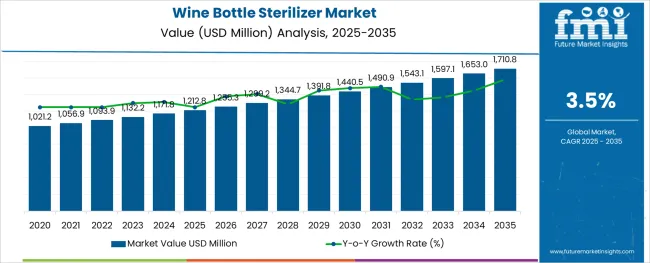
The wine bottle sterilizer market is witnessing progressive growth as wineries and bottling facilities intensify their focus on hygiene, product integrity, and operational efficiency. The market has been propelled by increasing quality control requirements and the rising demand for contamination-free wine packaging to meet both regulatory and consumer expectations.
Advancements in sterilization technologies combined with the premiumization trend in the wine industry are encouraging the adoption of efficient sterilization equipment. Growing awareness about the impact of sterilization on shelf life and taste preservation has further motivated producers to upgrade their facilities.
Future growth is expected to be supported by innovations in energy efficient designs, integration with automated bottling lines, and the need to meet international export standards. These factors are creating a favorable environment for sustained demand and technological evolution within the market.
The market is segmented by Type, Material, Application, and Distribution Channel and region. By Type, the market is divided into Electric and Non-electric. In terms of Material, the market is classified into Stainless Steel, Plastic, and Glass. Based on Application, the market is segmented into Wineries, Restaurants, Bars, and Hotels. By Distribution Channel, the market is divided into Supermarkets/Hypermarkets, Speciality Stores, Convenience Stores, and E-commerce Websites. Regionally, the market is classified into North America, Latin America, Western Europe, Eastern Europe, Balkan & Baltic Countries, Russia & Belarus, Central Asia, East Asia, South Asia & Pacific, and the Middle East & Africa.
The market is segmented by Type, Material, Application, and Distribution Channel and region. By Type, the market is divided into Electric and Non-electric. In terms of Material, the market is classified into Stainless Steel, Plastic, and Glass. Based on Application, the market is segmented into Wineries, Restaurants, Bars, and Hotels. By Distribution Channel, the market is divided into Supermarkets/Hypermarkets, Speciality Stores, Convenience Stores, and E-commerce Websites. Regionally, the market is classified into North America, Latin America, Western Europe, Eastern Europe, Balkan & Baltic Countries, Russia & Belarus, Central Asia, East Asia, South Asia & Pacific, and the Middle East & Africa.
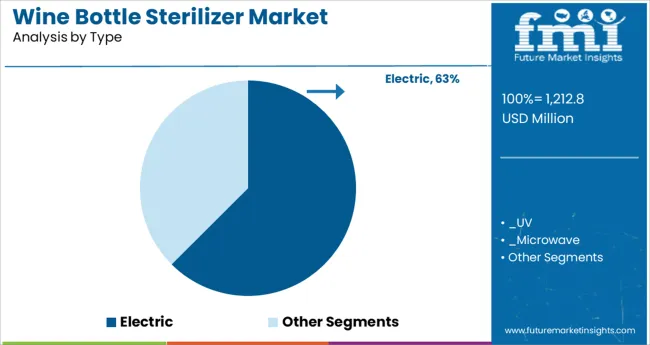
When segmented by type, electric sterilizers are expected to hold 62.5% of the market revenue in 2025, establishing their position as the dominant type segment. This leadership is attributed to the ease of integration with automated bottling systems and the superior control offered over temperature and sterilization cycles.
Electric units have been adopted widely due to their consistency in achieving high sanitation standards, which is critical for maintaining wine quality. Compact designs and energy efficient configurations have enabled their deployment even in space constrained facilities.
The ability to support programmable operations and reduced reliance on manual intervention has further enhanced productivity and minimized human error. Collectively, these operational and quality assurance benefits have cemented the electric segment’s prominence in the market.
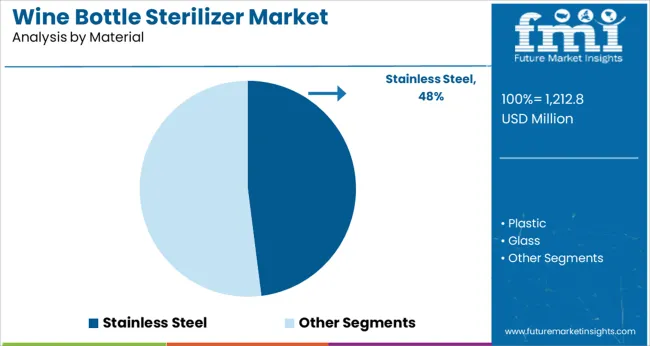
Segmenting by material shows that stainless steel is projected to contribute 48.0% of the market revenue in 2025, making it the leading material segment. This dominance is driven by the material’s inherent properties such as corrosion resistance, durability, and ease of cleaning, which are essential in maintaining sanitary conditions.
Stainless steel equipment has been preferred for its ability to withstand repeated sterilization cycles without compromising structural integrity. Its compatibility with both high temperature and chemical sanitization processes has also strengthened its adoption.
Furthermore, the aesthetic appeal and longevity of stainless steel have reinforced its position as the material of choice in professional winery environments where reliability and hygiene are paramount.
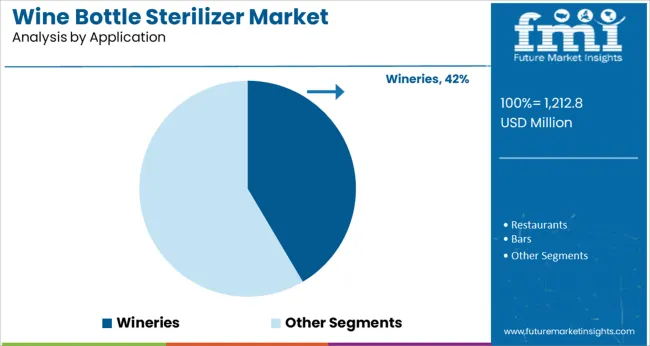
When segmented by application, wineries are anticipated to command 41.5% of the market revenue in 2025, confirming their leadership in the application domain. This prominence is driven by the critical role sterilization plays in preserving wine quality and preventing contamination during bottling.
Wineries have prioritized investment in specialized sterilizers to comply with stringent hygiene standards and to safeguard brand reputation. The adoption of advanced sterilization equipment has been accelerated by the growing scale of production and the need to reduce downtime between bottling batches.
Additionally, wineries’ focus on maintaining product consistency and extending shelf life has intensified the integration of efficient sterilization solutions into their operations. This focus on operational excellence and regulatory compliance has solidified wineries as the leading application segment in the market.
The global market for wine bottle sterilizers increased from USD 1021.2 million to USD 1,093.9 million between 2020 and 2025 with a CAGR of 3.3%.
The industry is expanding due to the rising demand for wine on a global scale along with the rising adoption of organic wines. As mainstream audiences develop an awareness of the health advantages of drinking wine, a pathway for wine bottle sterilizers becomes increasingly crucial.
Short Term (2025 to 2029): The rising disposable incomes and changing lifestyle trends are driving the demand for premium wines, which in turn is bolstering the market growth. Moreover, home brewing is becoming progressively trendy as a leisure activity in developed nations which necessitates the deployment of wine bottle sterilizers.
Medium Term (2029 to 2035): The proliferation of hypermarkets and supermarkets, wine shops, and online platforms for e-tailing, as well as rising wine prices, will broaden the product's appeal. Wine bottle sterilizers are likely to become additional popular as wine bars and eateries proliferate.
Long Term (2035 to 2035): Manufacturers are working on developing wine bottle sterilizers that are more effective and less expensive with the help of technological breakthroughs in sterilizing technology.
During the forecast period, the global wine bottle sterilizer market is anticipated to grow from USD 1,132.2 Million in 2025 to USD 1,597.1 Million by 2035 with a CAGR of 3.5%.
Wineries have long been engaged in the production and sale of wine. However, there has been a rise in demand for wine bottle sterilizers in recent years. Wine bottle sterilization is an essential stage in the winemaking process, and many wineries are increasingly asking for sterilizers designed exclusively for wine bottles.
An electric wine bottle sterilizer is an easy and effective way to clean your wine bottles. This type of sterilizer uses electricity to heat up a small element inside the device, which in turn sterile the bottles. Here are some of the advantages of using an electric Wine Bottle Sterilizer:
Wine bottle sterilizers come in many different shapes, sizes, and materials. The most common wine bottle sterilizers are made of plastic, glass, or metal. Each type of sterilizer has its own advantages and disadvantages.
Plastic wine bottle sterilizers are preferred by consumers mostly as these are the least expensive option. They are also the lightest weight and most portable option. They might not survive as long, however, as they are not as strong as glass or metal sterilizers.
Glass wine bottle sterilizers are not only more expensive than plastic but also more durable. However, they are also likely to break if dropped. Since they are heavier than plastic sterilizers, transportation might be more challenging.
Metal wine bottle sterilizers are both more expensive and durable options than the rest. They will not break if dropped and will last for many years with proper care.
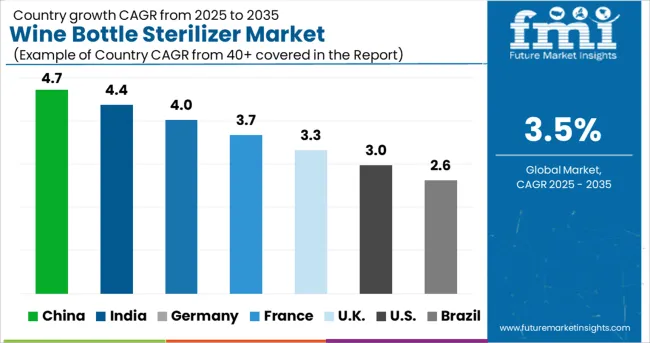
Owing to the huge demand for wine and spirits from developing nations like Brazil and Mexico, North America now has a lion's share of the global wine bottle sterilizer market in terms of revenue. The contribution of the United States is implacable in holding this huge market share.
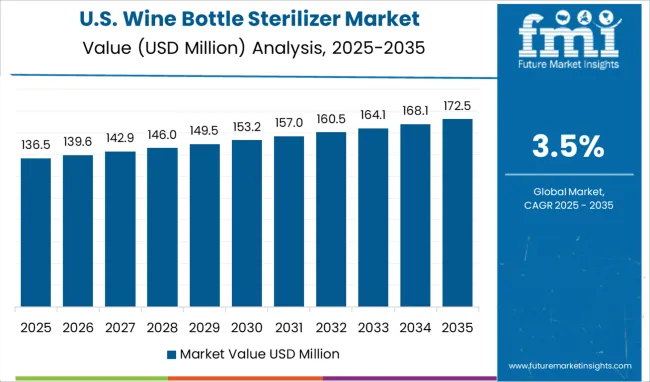
With a market share of 37.7% and a projected value of USD 1212.8 million in 2025, the USA wine bottle sterilizer market is seeing significant growth. Wines have been produced in the United States for a very long time, and the nation now considers wine goods to be an important meal component. The industry is being driven by the fact that drinking wine has become a sign of social standing, particularly among millennials and younger generations of the state.
In the past, wine was typically packaged in glass bottles and stored in a cool, dark place by wine manufacturers in the country. They have now recognized that wine must be stored in a sterile environment in order to prevent spoilage. This has resulted in the high adoption of sterilizers by wineries, bars, and restaurants. Additionally, it is anticipated that increased awareness of the need of upholding quality standards would further fuel product demand.
The most prolific wine producers are located in European nations. Since wine has always been a significant element of the vibrant European culture and continues to be, the European wine industry is sophisticated. Additionally, the wine bottle sterilizer market in this region has expanded as a result of the surge in wine drinking with food at home. Thus, as a result of the awareness of the need to protect wine from any sort of contaminants, the European wine bottle sterilizer market likewise has high development prospects. The United Kingdom and Germany are the most lucrative markets for wine bottle sterilizers in Europe.
| Country | United Kingdom |
|---|---|
| Growth Factor | Owing to its long reputation as a top-notch wine producer, the United Kingdom wine bottle sterilizer market has a significant market share. Furthermore, the United Kingdom has witnessed the effect of the Covid-19 pandemic, which in turn has surged the adoption of wine bottle sterilizers. Manufacturers in this country are experimenting with the latest technology owing to the reputation of wine here. An important area where United Kingdom manufacturers are innovating is in the design of their products. Additionally, these products are often very easy to use, making them perfect for even the most novice wine drinkers. CAGR - 6.5% |
| Country | Germany |
|---|---|
| Growth Factor | In recent years, Germany has become a leading innovator in the wine bottle sterilizer market. Manufacturers in this country have developed a number of new and innovative products that are helping to make the sterilization process more efficient and effective. One of the most popular innovations in this space is the use of UV light to sterilize wine bottles. This technology is becoming increasingly popular as it is shown to be more effective than other methods, such as using chemicals or steam. Market Share - 21.9% |
The wine bottle sterilizer market requires a revamp, hence, new entrants are evolving to penetrate in the market. Start-ups worldwide are longing to participate in several events to bring their own products. To meet customer demand and improve their brand's reputation, the well-known businesses operating in the market provide unique items. Using this tactic, businesses could be able to improve their brand image. In addition, implementing innovative manufacturing technology enables businesses to save labor expenses, increase productivity, improve operational efficiency, and meet organizational objectives.
Top Start-ups to Keep an Eye on
| Start-up Company | CP Lab Safety |
|---|---|
| Country | United States |
| Description | The company offers cleaning and sterilizing services. The company is ISO-certified and FDA-registered. Its facility brags advanced linear accelerators that consent for high volume fabrication providing undeviating sterilization to the product. |
| Start-up Company | Ava Winery |
|---|---|
| Country | United States |
| Description | This San Francisco-based start-up intents to disrupt high-end wines by propositioning bottles of chemically identical wine low-cost and more sustainably. |
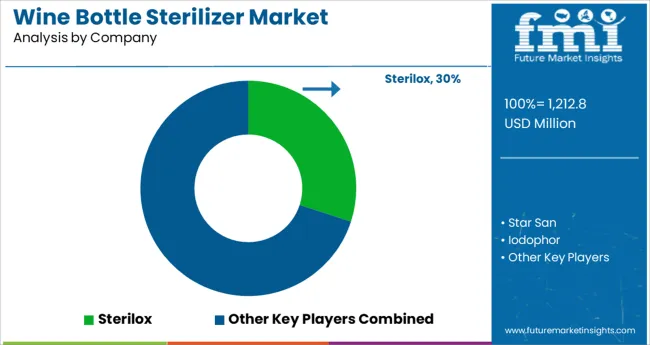
The competitive landscape of the Wine Bottle Sterilizer market is quite fragmented with the presence of a large number of small and medium-sized players. The key players in the market are focused on expanding their product portfolio and geographical reach to gain a competitive edge over their peers. The leading players in the market are also investing in research & development activities to develop innovative products.
Creating solutions for sterilization and disinfection is the focus of the manufacturer SterilOx. In the United Arab Emirates, the corporation works with a group of businessmen and engineers along with the Russian Research & Development Institute to operate this company. The company offers highly efficient, all-natural, and environment-friendly sanitizers and sterilizers in a single solution using a full-cycle production facility and local ingredients. Additionally, it provides a comprehensive, customized solution that works for a variety of locations.
On the other hand, Wine Guardian is the industry pioneer in wine cellar chilling. It is an air innovation company that offers wine cellar cooling units to meet every requirement, from the largest commercial cellars to small cellars for wine storage at home.
Aquatech BM is another important key player in the market. The company has a team of professionals who possess vast experience in the design and production of industrial and commercial sterilization equipment including bottle washers. Its bottle washers are used by several industries such as breweries, dairy farms, laboratories, wineries, and more. The company strives to offer dependable products that suit the requirements and budget of the customers.
Recent Developments
| Attribute | Details |
|---|---|
| Forecast Period | 2025 to 2035 |
| Historical Data Available for | 2020 to 2025 |
| Market Analysis | million for Value and Units for Volume |
| Key Regions Covered | North America; Latin America; Europe; Asia Pacific; Oceania; Middle East and Africa (MEA) |
| Key Countries Covered | USA, Canada, Mexico, Germany, United Kingdom, France, Italy, Spain, China, Japan, India, South Korea, Australia, Brazil, Argentina, South Africa, UAE |
| Key Segments Covered | Type, Material, Application, Distribution Channel, Region |
| Key Companies Profiled | Sterilox; Star San; Iodophor; Wine Guardian; The Vintner's Friend; The Champagne Maker; The Wine Doctor; Aquatech BM; Midwest Supplies LLC; Presque Isle Wine Cellars |
| Report Coverage | Company Share Analysis, DROT Analysis, Market Dynamics and Challenges, Strategic Growth Initiatives, Market Forecast, Competitive Landscape, |
| Customization & Pricing | Available upon Request |
The global wine bottle sterilizer market is estimated to be valued at USD 1,212.8 million in 2025.
It is projected to reach USD 1,710.8 million by 2035.
The market is expected to grow at a 3.5% CAGR between 2025 and 2035.
The key product types are electric, _uv, _microwave, _ozone sterilizers and non-electric.
stainless steel segment is expected to dominate with a 48.0% industry share in 2025.






Our Research Products

The "Full Research Suite" delivers actionable market intel, deep dives on markets or technologies, so clients act faster, cut risk, and unlock growth.

The Leaderboard benchmarks and ranks top vendors, classifying them as Established Leaders, Leading Challengers, or Disruptors & Challengers.

Locates where complements amplify value and substitutes erode it, forecasting net impact by horizon

We deliver granular, decision-grade intel: market sizing, 5-year forecasts, pricing, adoption, usage, revenue, and operational KPIs—plus competitor tracking, regulation, and value chains—across 60 countries broadly.

Spot the shifts before they hit your P&L. We track inflection points, adoption curves, pricing moves, and ecosystem plays to show where demand is heading, why it is changing, and what to do next across high-growth markets and disruptive tech

Real-time reads of user behavior. We track shifting priorities, perceptions of today’s and next-gen services, and provider experience, then pace how fast tech moves from trial to adoption, blending buyer, consumer, and channel inputs with social signals (#WhySwitch, #UX).

Partner with our analyst team to build a custom report designed around your business priorities. From analysing market trends to assessing competitors or crafting bespoke datasets, we tailor insights to your needs.
Supplier Intelligence
Discovery & Profiling
Capacity & Footprint
Performance & Risk
Compliance & Governance
Commercial Readiness
Who Supplies Whom
Scorecards & Shortlists
Playbooks & Docs
Category Intelligence
Definition & Scope
Demand & Use Cases
Cost Drivers
Market Structure
Supply Chain Map
Trade & Policy
Operating Norms
Deliverables
Buyer Intelligence
Account Basics
Spend & Scope
Procurement Model
Vendor Requirements
Terms & Policies
Entry Strategy
Pain Points & Triggers
Outputs
Pricing Analysis
Benchmarks
Trends
Should-Cost
Indexation
Landed Cost
Commercial Terms
Deliverables
Brand Analysis
Positioning & Value Prop
Share & Presence
Customer Evidence
Go-to-Market
Digital & Reputation
Compliance & Trust
KPIs & Gaps
Outputs
Full Research Suite comprises of:
Market outlook & trends analysis
Interviews & case studies
Strategic recommendations
Vendor profiles & capabilities analysis
5-year forecasts
8 regions and 60+ country-level data splits
Market segment data splits
12 months of continuous data updates
DELIVERED AS:
PDF EXCEL ONLINE
Wine Packaging Market Size and Share Forecast Outlook 2025 to 2035
Wine Bag Market Forecast and Outlook 2025 to 2035
Wine Cork Market Size and Share Forecast Outlook 2025 to 2035
Wine Barrel Market Size and Share Forecast Outlook 2025 to 2035
Wine Cellar Market Size and Share Forecast Outlook 2025 to 2035
Wine Enzymes Market Analysis Size Share and Forecast Outlook 2025 to 2035
Wine Box Market Size and Share Forecast Outlook 2025 to 2035
Wine Fining Agent Market Size and Share Forecast Outlook 2025 to 2035
Wine, Scotch, and Whiskey Barrels Market Size and Share Forecast Outlook 2025 to 2035
Wine Totes Packaging Market Size and Share Forecast Outlook 2025 to 2035
Wine Fermentation Equipment Market Size and Share Forecast Outlook 2025 to 2035
Wine Processing Equipment Market Size and Share Forecast Outlook 2025 to 2035
Wine Racks Market Size and Share Forecast Outlook 2025 to 2035
Wine Filling Machine Market Size and Share Forecast Outlook 2025 to 2035
Wine Extract Market Size and Share Forecast Outlook 2025 to 2035
Wine Market Analysis - Size, Share, and Forecast Outlook 2025 to 2035
Wine Tourism Market Analysis - Size, Share, and Forecast Outlook 2025 to 2035
Wine Destemmer Market - Growth & Demand 2025 to 2035
Wine Filtering Machine Market Expansion - Filtration & Winemaking Technology 2025 to 2035
Wine Crusher Market Growth - Winemaking Equipment & Industry Trends 2025 to 2035

Thank you!
You will receive an email from our Business Development Manager. Please be sure to check your SPAM/JUNK folder too.
Chat With
MaRIA